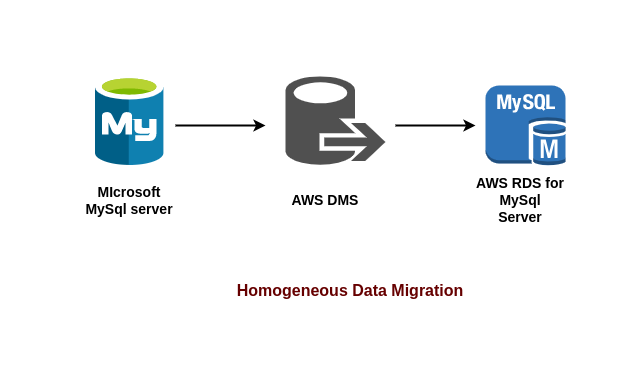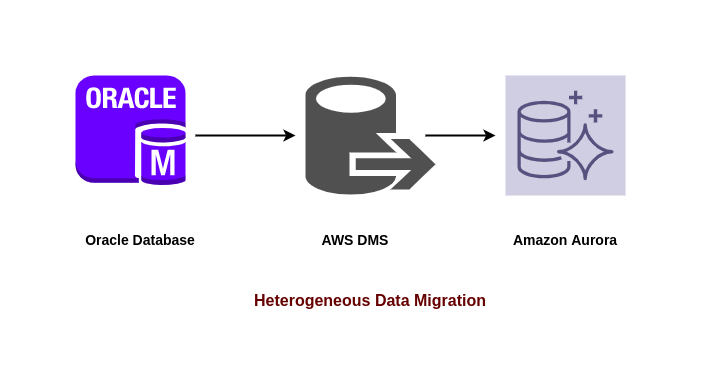When it comes to migration, all companies have the same goal: to make the transition as easy, seamless, and safe as possible.
However, Many businesses are grappling with the most pressing issue: how to manage their vast amounts of data.
Traditional on-premises database management tools aren’t up to the task of dealing with today’s data management difficulties.
As a result, the AWS database migration service (DMS) is a safe and secure way to take advantage of cloud computing’s full potential.
What is AWS DMS?
The AWS Database Migration Service (DMS) is a cloud service that makes migrating relational databases, data warehouses, NoSQL databases, as well as other types of data stores simple.
The two data stores i.e., the source and the target, are known as endpoints
It’s worth noting that in order to use the AWS Database migration service, customers must have at least one endpoint on an AWS service.
It’s also worth noting that users can’t utilize AWS data migration services to migrate from one on-premises database to another on-premises database.
They can also make use of the capacity of continuous data replication with increased availability.
Types of DMS
There are 2 types of AWS DMS –
Homogeneous Database Migration
Homogenous migrations occur when data is transferred across databases that are of the same type.
Such as Oracle to Amazon RDS for Oracle, MySQL to Amazon Aurora, MySQL to Amazon RDS for MySQL, or Microsoft SQL Server to Amazon RDS for SQL Server.

Heterogeneous Database Migration
DMS, on the other hand, will move data between different types of databases in heterogeneous migrations.
Such as Oracle to Amazon Aurora, Oracle to PostgreSQL, or Microsoft SQL Server to MySQL migrations.

AWS Schema Conversion Tool(SCT)
The AWS SCT converts the source database schema and a considerable lot of the database code objects, such as views, stored procedures, and functions, to a target database-compatible format.
Therefore, any objects that cannot be converted automatically are identified and must be converted manually to complete the migration.
As part of a database-schema-conversion effort, SCT can examine your application source code for embedded SQL statements and convert them.
SCT can help transfer data from a variety of data warehouses to Amazon Redshift utilizing built-in data migration agents once schema conversion is complete.
AWS DMS Supported Databases
AWS DMS supports a range of Source and Target database engines –
Source Database Engines
- Oracle Database and Data Warehouse
- Microsoft Azure SQL Database and Server
- Teradata
- IBM Netezza
- Greenplum
- HPE Vertica
- MySQL
- PostgreSQL
- IBM DB2 LUW
- Apache Cassandra
- SAP ASE
- Amazon Redshift
- Azure Synapse Analytics
- Snowflake
Target Database Engines
- Amazon Aurora MySQL
- Amazon Aurora PostgreSQL
- MariaDB
- MySQL
- PostgreSQL
- Amazon Redshift
- Aurora MySQL
- Aurora PostgreSQL
- Microsoft SQL Server
- Amazon DynamoDB
Benefits of AWS DMS
There are multiple benefits of using the AWS database migration service –
- The AWS Database Migration Service assists you in migrating your databases to AWS with minimal downtime.
- The AWS DMS is a low-cost option. Only the computational resources consumed during the migration process, as well as any additional log storage, will be charged.
- In addition, the Multi-AZ feature provides high availability for database migration and continuous data replication.
- However, there are no drivers or software to install, and in most circumstances, there are no changes to the source database.
- DMS maintains all aspects of the migration process once it begins, including automatically replicating data changes made in the source database during the migration.
- During the migration, any data updates to the source database are continually replicated to the target, allowing the source database to remain fully operational during the process.
- The source and target databases, network connectivity, and replication instances are all constantly monitored.
- It is extremely resilient and self–healing. If the process is interrupted, it immediately restarts and resumes the migration from where it left off.
How does it work?
The AWS Database Migration Service (AWS DMS) is a web service that allows you to migrate data from one data store to another. Endpoints are the names for these two data storage.
You can migrate data between endpoints that use the same database engine, such as from one Oracle database to another Oracle database.
You can also migrate data between source and target endpoints that use different database engines, such as Oracle to PostgreSQL.
The only stipulation for using AWS DMS is that one of your endpoints be hosted on an AWS service. AWS DMS cannot be used to move data from one on-premises database to another.
Replication Instance
The Replication instance is simply an Amazon EC2 managed instance that hosts one or more replication tasks.
Therefore, based on the capabilities of a replication server and the features of the migration task, one replication instance can host one or more replication tasks.
Endpoints
The endpoints are used to connect to the source or target data repositories.
Endpoints can be created by giving information such as endpoint type, engine type, port, server name, credentials, and encryption techniques.
Replication Tasks
Replication tasks are the final element of the AWS Database Migration service’s structure. The final step before beginning a migration procedure is to create a replication task.
During the construction of a replication task, users must provide certain task settings.

AWS DMS Fleet Advisor
AWS DMS Fleet Advisor is a free and completely managed AWS Database Migration Service capability (AWS DMS).
In addition, it helps you transfer database and analytics fleets to the cloud at scale with minimal effort by automating migration plans.
However, It’s for users who want to move a large number of database and analytics servers to AWS.
Use AWS DMS Fleet Advisor to discover and assess your OLTP and OLAP database workloads when moving to AWS’ target services.
By estimating the complexity of moving your source databases to target services in AWS, Fleet Advisor helps you create a customized migration plan.
Pricing
The reader’s primary concern should now be DMS pricing. Your replication instances and any additional log storage are the only things you have to pay for.
For most replications, each database migration instance has enough storage for swap space, replication logs, and data cache, and inbound data transmission is free.
On-demand Instance pricing
The T2, T3, C4, C5, R4, and R5 instance classes are now supported by AWS Database Migration Service.
T2/T3 instances are low-cost standard instances with the ability to burst above the baseline level of CPU performance.
The C4, R4, and R5 instances are optimized for maximum CPU performance. If you’re transferring a huge database, you should use C4 or R4/R5 instances to speed things up.
Let’s take a few examples of the T2/T3 series –
| Instances | Price per hour(Single – AZ) | Price per hour(Multi-AZ) |
| t3.micro | $0.018 | $0.036 |
| t3.small | $0.036 | $0.072 |
| t3.medium | $0.073 | $0.146 |
| t3.large | $0.146 | $0.292 |
| t2.micro | $0.018 | $0.036 |
| t2.small | $0.036 | $0.072 |
| t2.medium | $0.073 | $0.146 |
| t2.large | $0.146 | $0.292 |
And this list goes long to the R4 family.
T3 CPU Credits
The cost of CPU Credits is $0.075 per vCPU-Hour. In all regions, the CPU Credit cost is the same for all T3 instance sizes.
Storage pricing
For swap space, replication logs, and data cache, each C4, R4, and R5 instance type offer 100GB of GP2 network-attached storage.
Each T2 and T3 instance type contains 50GB of GP2 network-attached storage.
If you want to store logs for a longer time, you can pay the following storage charges to extend the storage –
| Instance Type | Price per GB/month(Single – AZ) | Price per GB/month(Multi-AZ) |
| SSD Storage | $0.115 | $0.023 |
Data Transfer pricing
The transfer of data into AWS Database Migration Service is completely free.
It is also free to transfer between AWS DMS and databases in Amazon RDS and Amazon EC2 instances in the same Availability Zone.
When migrating your source database to a destination database in a different Availability Zone, Region, or outside of AWS, standard AWS data transfer rates apply.
Conclusion
So, if you’re thinking about moving your database to the cloud, consider AWS Database Migration Service as a viable solution.
This service’s dependability, combined with AWS’s reputation in cloud computing, delivers great assistance.
As a result, you can quickly set up a database migration infrastructure by specifying the different components in the AWS data migration service’s architecture.
You may also visit our Magento development services and quality Magento 2 Extensions.
For further help or queries, please contact us or raise a ticket.


Be the first to comment.